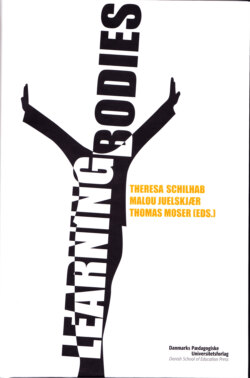Читать книгу Learning Bodies - Группа авторов - Страница 19
На сайте Литреса книга снята с продажи.
The argument from the perspective of evolution
ОглавлениеThe third argument has to do with the biological filtering of information. However compelling, the argument questions the idea of circumventing the body and directing certain combinations of stimuli straight to the brain. It may be logically appealing, but to allow one self to think of bypassing the body is, in fact, a mistake.
To comprehend and imitate the complexity of signals that impinges on the body is impossible.
We meet our environment at the surface of our body. Our senses (and their location in the body) have evolved and become susceptible to environmental features over time in a close race in the best interests of organisms7. Senses cannot be studied without taking into account the environment they were shaped by. Intertwined development is carved into the delicate constitution of the body from the lowest molecular level of co-operative second messenger cascades to idiosyncratic features of sense organs. Every subtle cellular mechanism consists of elements that can be traced back to tricks that have worked since the beginning of life. The sophistication of each mechanism is so formidable that it may prove impossible to disentangle.
In that understanding, the body is indispensable because it literally carries with it examples of processes that make evolutionary sense and that ultimately dictate the workings of the brain.
The intricacy of the visual system in primates8, including humankind, is composed of millions of years of reality checks. Seeing would never have evolved if vulnerability to radiant emittance had not paid off (Schilhab 2007). Thus, the fact that different features emit radiation from the sun differently forms the basis of colour sensitivity.
To grasp the arbitrariness of our senses, we could make the same point with echolocation in bats. Bats “see” the environment by emitting sounds (and sound waves) that bounce back when they encounter obstacles. It is not imperative that bats use echolocation and humans do not to navigate in the world. The reason they do so is conditional on evolutionary circumstances.
Organisms have achieved idiosyncratic sensitivity (i.e., a visual system or echolocation) to their surroundings because in the long run it increased their chances of survival9.
Biological filtering also embraces innate10 learning strategies such as habituation, sensitization and conditioning. In the same way, the evolutionary fingerprint stipulates the extent to which conditioning comes into play. If rats drink something new (sweet or salty) and become ill (induced by X-rays), they avoid drinking water with that taste in future. But if the experiment only involves an electric shock, they do not seem to associate the shock with what they have drunk. On the other hand, if rats drink water accompanied with bright flashes and clicking noises and then receive a shock, they will readily learn to avoid the water, while nausea is without effect (Byrne 1995).
Congruence between body and environment results from considerable numbers of tests inimitable in complexity and therefore incomprehensible.
In every respect the body is an imprint of evolutionary progress and time. Therefore, what can in fact be processed by the brain is uniquely determined by the history of the body as the resonator of evolutionary trial and errors. From that perspective, the brain is but a means to solve environmental challenges and part and parcel with other organs such as the lungs, heart and eyes, which serve the function of sustaining life in the body.
